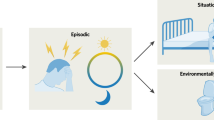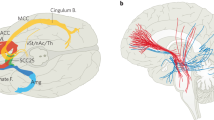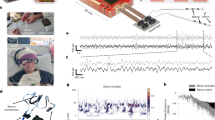Abstract
Recent research and technological developments have led to an expanding number of novel and rapidly acting therapeutics being developed across a variety of neuropsychiatric disorders. Novel medical devices range from implantable and non-invasive brain stimulating and recording technologies to digital therapeutics. This perspective provides an overview of FDA regulatory oversight for medical devices, including a discussion of regulatory pathways and the review of neuromodulation devices for psychiatric disorders. We highlight the importance of early engagement with FDA and special programs that may be useful to device developers participating in interactions with the FDA that are solution focused. We explore current novel and rapid treatments for psychiatric disorders and those on the horizon. Lastly, we provide considerations for developers in navigating the regulatory landscape for neuromodulation devices intended for psychiatric disorders, including approaches to incorporating patient perspectives.
This is a preview of subscription content, access via your institution
Access options
Subscribe to this journal
Receive 13 print issues and online access
$259.00 per year
only $19.92 per issue
Buy this article
- Purchase on Springer Link
- Instant access to full article PDF
Prices may be subject to local taxes which are calculated during checkout
Similar content being viewed by others
References
U.S. Food and Drug Administration (FDA). Devices regulated by the center for biologics evaluation and research. https://www.fda.gov/vaccines-blood-biologics/premarket-notification-510k-process-cber-regulated-products/devices-regulated-center-biologics-evaluation-and-research Accessed August 2023.
U.S. Food and Drug Administration (FDA). How to study and market your device. https://www.fda.gov/medical-devices/device-advice-comprehensive-regulatory-assistance/how-study-and-market-your-device Accessed August 2023.
U.S. Food and Drug Administration (FDA). Center for devices and radiological health. https://www.fda.gov/about-fda/fda-organization/center-devices-and-radiological-health Accessed August 2023.
U.S. Food and Drug Administration (FDA). Classify your medical device. https://www.fda.gov/medical-devices/overview-device-regulation/classify-your-medical-device Accessed August 2023.
National Archives. Code of Federal Regulations 21 CFR Part 882. https://www.ecfr.gov/current/title-21/chapter-I/subchapter-H/part-882?toc=1 Accessed August 2023.
U.S. Food and Drug Administration (FDA). CDRH transparency: total product life cycle (TPLC). https://www.fda.gov/about-fda/cdrh-transparency/cdrh-transparency-total-product-life-cycle-tplc Accessed August 2023.
U.S. Food and Drug Administration (FDA). General controls for medical devices. https://www.fda.gov/medical-devices/regulatory-controls/general-controls-medical-devices Accessed August 2023.
U.S. Food and Drug Administration (FDA). Regulatory controls. https://www.fda.gov/medical-devices/overview-device-regulation/regulatory-controls Accessed August 2023.
U.S. Food and Drug Administration (FDA). Premarket notification 510(k). https://www.fda.gov/medical-devices/premarket-submissions-selecting-and-preparing-correct-submission/premarket-notification-510k Accessed August 2023.
U.S. Food and Drug Administration (FDA). Premarket approval (PMA). https://www.fda.gov/medical-devices/premarket-submissions-selecting-and-preparing-correct-submission/premarket-approval-pma Accessed August 2023.
U.S. Food and Drug Administration (FDA). Humanitarian device exemption (HDE). https://www.fda.gov/medical-devices/premarket-submissions-selecting-and-preparing-correct-submission/humanitarian-device-exemption Accessed August 2023.
U.S. Food and Drug Administration (FDA). Humanitarian device exemption (HDE). Classification name: deep brain stimulator for obsessive compulsive disorder (H050003). https://www.accessdata.fda.gov/scripts/cdrh/cfdocs/cfhde/hde.cfm?id=375533 Accessed August 2023.
U.S. Food and Drug Administration (FDA). IDE approval process. https://www.fda.gov/medical-devices/investigational-device-exemption-ide/ide-approval-process Accessed August 2023.
U.S. Food and Drug Administration (FDA). Significant risk and nonsignificant risk medical device studies. https://www.fda.gov/regulatory-information/search-fda-guidance-documents/significant-risk-and-nonsignificant-risk-medical-device-studies Accessed August 2023.
U.S. Food and Drug Administration (FDA). Requests for feedback and meetings for medical device submissions: the Q-submission program. https://www.fda.gov/regulatory-information/search-fda-guidance-documents/requests-feedback-and-meetings-medical-device-submissions-q-submission-program Accessed August 2023.
U.S. Food and Drug Administration (FDA). Breakthrough devices program. https://www.fda.gov/medical-devices/how-study-and-market-your-device/breakthrough-devices-program Accessed August 2023.
U.S. Food and Drug Administration (FDA). Total product life cycle advisory program (TAP). https://www.fda.gov/medical-devices/how-study-and-market-your-device/total-product-life-cycle-advisory-program-tap Accessed August 2023.
U.S. Food and Drug Administration (FDA). Safer technologies program (SteP) for medical devices. https://www.fda.gov/medical-devices/how-study-and-market-your-device/safer-technologies-program-step-medical-devices Accessed August 2023.
U.S. Food and Drug Administration (FDA). 510(k) Premarket notification. Device classification name: transcranial magnetic stimulator (K173620). https://www.accessdata.fda.gov/scripts/cdrh/cfdocs/cfPMN/pmn.cfm?ID=K173620 Accessed August 2023.
U.S. Food and Drug Administration (FDA). 510(k) Premarket notification. Device classification name: transcranial magnetic stimulator (K182700). https://www.accessdata.fda.gov/scripts/cdrh/cfdocs/cfpmn/pmn.cfm?ID=K182700 Accessed August 2023.
U.S. Food and Drug Administration (FDA). 510(k) Premarket notification. Device classification name: transcranial magnetic stimulator (K182853). https://www.accessdata.fda.gov/scripts/cdrh/cfdocs/cfpmn/pmn.cfm?ID=K182853 Accessed August 2023.
U.S. Food and Drug Administration (FDA). 510(k) Premarket notification. Device classification name: transcranial magnetic stimulator (K201158). https://www.accessdata.fda.gov/scripts/cdrh/cfdocs/cfpmn/pmn.cfm?ID=K201158 Accessed August 2023.
U.S. Food and Drug Administration (FDA). 510(k) Premarket notification. Device classification name: transcranial magnetic stimulator (K203735). https://www.accessdata.fda.gov/scripts/cdrh/cfdocs/cfpmn/pmn.cfm?ID=K203735 Accessed August 2023.
U.S. Food and Drug Administration (FDA). 510(k) Premarket notification. Device classification name: transcranial magnetic stimulator (K220177). https://www.accessdata.fda.gov/scripts/cdrh/cfdocs/cfpmn/pmn.cfm?ID=K220177 Accessed August 2023.
U.S. Food and Drug Administration (FDA). Device classification under section 513(f)(2)(De Novo). Device classification name: transcranial magnetic stimulation system for obsessive-compulsive disorder (DEN170078). https://www.accessdata.fda.gov/scripts/cdrh/cfdocs/cfpmn/denovo.cfm?id=DEN170078 Accessed August 2023.
U.S. Food and Drug Administration (FDA). 510(k) Premarket notification. device classification name: transcranial magnetic stimulation system for obsessive-compulsive disorder (K193006). https://www.accessdata.fda.gov/scripts/cdrh/cfdocs/cfpmn/pmn.cfm?ID=K193006 Accessed August 2023.
U.S. Food and Drug Administration (FDA). 510(k) Premarket notification. Device classification name: transcranial magnetic stimulation system for obsessive-compulsive disorder (K212289). https://www.accessdata.fda.gov/scripts/cdrh/cfdocs/cfpmn/pmn.cfm?ID=K212289 Accessed August 2023.
U.S. Food and Drug Administration (FDA). 510(k) Premarket notification. Device classification name: transcranial magnetic stimulator (K222171). https://www.accessdata.fda.gov/scripts/cdrh/cfdocs/cfpmn/pmn.cfm?ID=K222171 Accessed August 2023.
U.S. Food and Drug Administration (FDA). 510(k) Premarket notification. Device classification name: transcranial magnetic stimulation system for obsessive-compulsive disorder (K221129). https://www.accessdata.fda.gov/scripts/cdrh/cfdocs/cfpmn/pmn.cfm?ID=K221129 Accessed August 2023.
U.S. Food and Drug Administration (FDA). Device classification under section 513(f)(2)(De Novo). Device classification name: percutaneous nerve stimulator for opioid withdrawal (DEN170018). https://www.accessdata.fda.gov/scripts/cdrh/cfdocs/cfpmn/denovo.cfm?id=DEN170018 Accessed August 2023.
U.S. Food and Drug Administration (FDA). 510(k) Premarket notification. Device classification name: percutaneous nerve stimulator for opioid withdrawal (K173861). https://www.accessdata.fda.gov/scripts/cdrh/cfdocs/cfPMN/pmn.cfm?ID=K173861 Accessed August 2023.
U.S. Food and Drug Administration (FDA). 510(k) Premarket notification. Device classification name: percutaneous nerve stimulator for opioid withdrawal (K201873). https://www.accessdata.fda.gov/scripts/cdrh/cfdocs/cfPMN/pmn.cfm?ID=K201873 Accessed August 2023.
U.S. Food and Drug Administration (FDA). Device classification under section 513(f)(2)(De Novo). Device classification name: transcutaneous nerve stimulator for ADHD (DEN180041). https://www.accessdata.fda.gov/scripts/cdrh/cfdocs/cfpmn/denovo.cfm?id=DEN180041 Accessed August 2023.
U.S. Food and Drug Administration (FDA). Device classification under section 513(f)(2)(De Novo). Device classification name: digital therapeutic software for attention deficit hyperactivity (DEN200026). Disorder. https://www.accessdata.fda.gov/scripts/cdrh/cfdocs/cfpmn/denovo.cfm?id=DEN2000 Accessed August 2023.
U.S. Food and Drug Administration (FDA). Device classification under section 513(f)(2)(De Novo). Device classification name: digital therapy device to reduce sleep disturbance for psychiatric conditions (DEN200033). https://www.accessdata.fda.gov/scripts/cdrh/cfdocs/cfpmn/denovo.cfm?id=DEN200033 Accessed August 2023.
U.S. National Library of Medicine Clinicaltrials.gov. Rapid acting TMS for suicide ideation in depression. https://clinicaltrials.gov/ct2/show/NCT05100004?term=stimulation&cond=suicide&draw=2&rank=1 Accessed August 2023.
U.S. National Library of Medicine Clinicaltrials.gov. Confirmatory efficacy and safety trial of magnetic seizure therapy for depression (CREST-MST). https://clinicaltrials.gov/ct2/show/NCT03191058?term=magnetic+seizure+therapy&cond=Depression&draw=2&rank=1 Accessed August 2023.
U.S. National Library of Medicine Clinicaltrials.gov. Low intensity focused ultrasound for emotion regulation (LIFUPEMOT). https://clinicaltrials.gov/ct2/show/NCT03782194?term=low+intensity+focused+ultrasound&cond=Psychiatric+Disorder&draw=2&rank=1 Accessed August 2023.
Sheth SA, Bijanki KR, Metzger B, Allawala A, Pirtle V, Adkinson JA, et al. Deep brain stimulation for depression informed by intracranial recordings. Biol Psychiatry. 2022;92:246–51.
Scangos KW, Khambhati AN, Daly PM, Makhoul GS, Sugrue LP, Zamanian H, et al. Closed-loop neuromodulation in an individual with treatment-resistant depression. Nat Med. 2021;27:1696–1700.
National Archives. Code of Federal Regulations. 21 CFR 882.5801. https://www.ecfr.gov/current/title-21/section-882.5801 Accessed 27 August 2023.
National Archives. Code of Federal Regulations. 21 CFR 882.5705. https://www.ecfr.gov/current/title-21/section-882.5705 Accessed 27 August 2023.
U.S. Food and Drug Administration (FDA). Digital health center of excellence. https://www.fda.gov/medical-devices/digital-health-center-excellence Accessed August 2023.
U.S. Food and Drug Administration (FDA). The 510(k) program: evaluating substantial equivalence in premarket notifications [510(k)]. July 28, 2014. https://www.fda.gov/regulatory-information/search-fda-guidance-documents/510k-program-evaluating-substantial-equivalence-premarket-notifications-510k Accessed August 2023.
U.S. Food and Drug Administration (FDA). Factors to consider when making benefit-risk determinations in medical device premarket approval and de novo classifications. August 30, 2019. https://www.fda.gov/regulatory-information/search-fda-guidance-documents/factors-consider-when-making-benefit-risk-determinations-medical-device-premarket-approval-and-de Accessed August 2023.
U.S. Food and Drug Administration (FDA). Benefit-risk factors to consider when determining substantial equivalence in premarket notifications (510(k)) with different technological characteristics. September 25, 2018. https://www.fda.gov/regulatory-information/search-fda-guidance-documents/benefit-risk-factors-consider-when-determining-substantial-equivalence-premarket-notifications-510k Accessed August 2023.
U.S. Food and Drug Administration (FDA). Factors to consider when making benefit-risk determinations for medical device investigational device exemptions. January 13, 2017. https://www.fda.gov/regulatory-information/search-fda-guidance-documents/factors-consider-when-making-benefit-risk-determinations-medical-device-investigational-device Accessed August 2023.
Congress.gov. Public law 114-255. https://www.congress.gov/114/plaws/publ255/PLAW-114publ255.pdf Accessed August 2023.
U.S. Food and Drug Administration (FDA). Focus area: patient-reported outcomes and other clinical outcome assessments. https://www.fda.gov/science-research/focus-areas-regulatory-science-report/focus-area-patient-reported-outcomes-and-other-clinical-outcome-assessments Accessed August 2023.
U.S. Food and Drug Administration (FDA). Patient preference information - voluntary submission, review in premarket approval applications, humanitarian device exemption applications, and de novo requests, and inclusion in decision summaries and device labeling. https://www.fda.gov/regulatory-information/search-fda-guidance-documents/patient-preference-information-voluntary-submission-review-premarket-approval-applications Accessed August 2023.
Hauber B, Mange B, Zhou M, Chaudhuri S, Benz HL, Caldwell B, et al. Parkinson’s patients’ tolerance for risk and willingness to wait for potential benefits of novel neurostimulation devices: a patient-centered threshold technique study. medical decision making policy & practice. 2021. https://doi.org/10.1177/2381468320978407.
Author information
Authors and Affiliations
Contributions
PDS wrote and edited the manuscript, AB wrote the Patient Perspectives section and contributed to editing the manuscript, DPM wrote the introduction, contributed to the Special Programs section and the Novel and Rapid treatments for Psychiatric disorders section, and edited the manuscript.
Corresponding author
Ethics declarations
Competing interests
The authors declare no competing interests.
Additional information
Publisher’s note Springer Nature remains neutral with regard to jurisdictional claims in published maps and institutional affiliations.
Rights and permissions
Springer Nature or its licensor (e.g. a society or other partner) holds exclusive rights to this article under a publishing agreement with the author(s) or other rightsholder(s); author self-archiving of the accepted manuscript version of this article is solely governed by the terms of such publishing agreement and applicable law.
About this article
Cite this article
Scott, P.D., Bajaj, A. & McMullen, D.P. Navigating the FDA regulatory landscape. Neuropsychopharmacol. 49, 18–22 (2024). https://doi.org/10.1038/s41386-023-01723-z
Received:
Revised:
Accepted:
Published:
Issue Date:
DOI: https://doi.org/10.1038/s41386-023-01723-z



